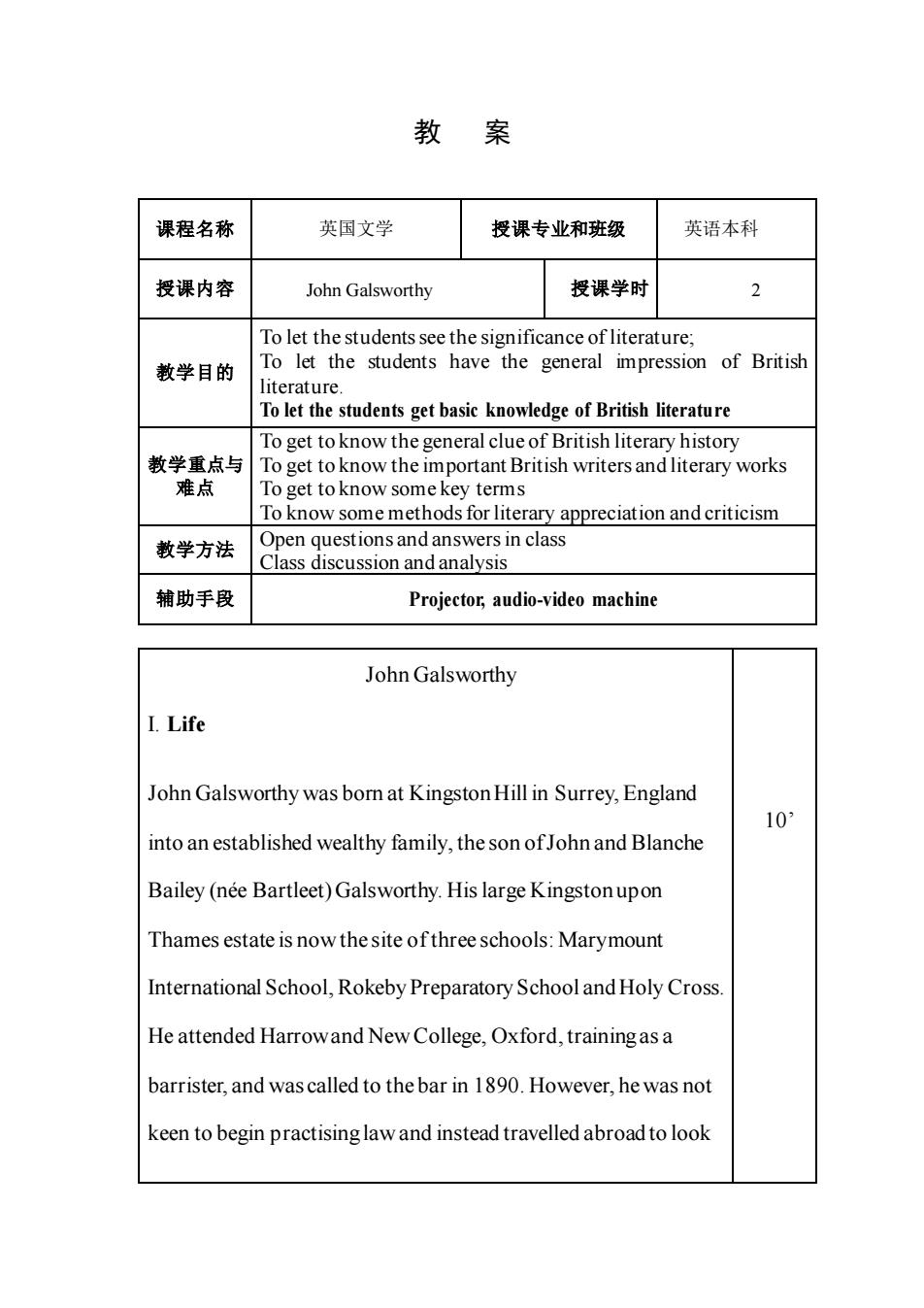
教案 课程名称 英国文学 授课专业和班级 英语本科 授课内容 John Galsworthy 授课学时 To let the students see the significance of literature 教学目的 To let the students have the general impression of British literature. To let the students get basic knowledge of British literature To get to know the general clue of British literary history 教学重点与To get to know the important British writers and literary works 难点 To get to know some key terms To know some methods for literary appreciation and criticism 教学方法 辅助手段 Projector,audio-video machine John Galsworthy I.Life John Galsworthy was born at Kingston Hill in Surrey,England 10 into an established wealthy family,the son ofJohn and Blanche Bailey(nee Bartleet)Galsworthy.His large Kingstonupon Thames estate is now the site ofthree schools:Marymount International School,Rokeby Preparatory School and Holy Cross. He attended Harrowand New College,Oxford,trainingasa barrister,and was called to the bar in 1890.However,he was not keen to begin practising law and instead travelled abroad to look
教 案 课程名称 英国文学 授课专业和班级 英语本科 授课内容 John Galsworthy 授课学时 2 教学目的 To let the students see the significance of literature; To let the students have the general impression of British literature. To let the students get basic knowledge of British literature 教学重点与 难点 To get to know the general clue of British literary history To get to know the important British writers and literary works To get to know some key terms To know some methods for literary appreciation and criticism 教学方法 Open questions and answers in class Class discussion and analysis 辅助手段 Projector, audio-video machine John Galsworthy I. Life John Galsworthy was born at Kingston Hill in Surrey, England into an established wealthy family, the son of John and Blanche Bailey (née Bartleet) Galsworthy. His large Kingston upon Thames estate is now the site of three schools: Marymount International School, Rokeby Preparatory School and Holy Cross. He attended Harrowand New College, Oxford, training as a barrister, and was called to the bar in 1890. However, he was not keen to begin practising law and instead travelled abroad to look 10’
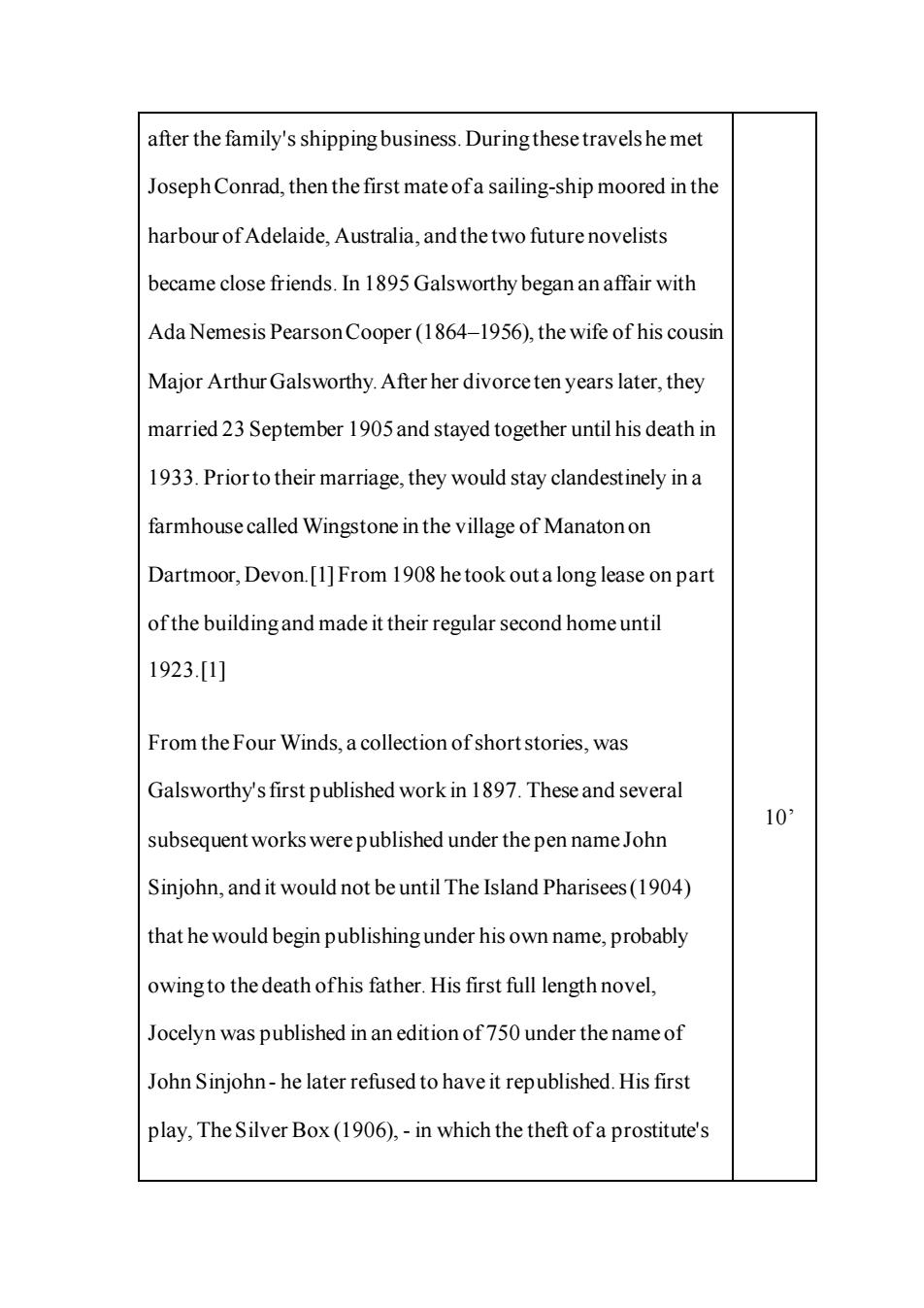
after the family's shipping business.Duringthese travelshe met Joseph Conrad,then the first mate ofa sailing-ship moored in the harbour of Adelaide.Australia.and the two future novelists became close friends.In 1895 Galsworthy began an affair with Ada Nemesis Pearson Cooper(1864-1956),the wife of his cousin Major Arthur Galsworthy.After her divorceten years later,they married 23 September 1905and stayed together until his death in 1933.Priorto their marriage,they would stay clandestinely in a farmhouse called Wingstone in the village of Manatonon Dartmoor,Devon.[1]From 1908 he took outa long lease on part of the building and made it their regular second home until 1923.[1 From the Four Winds,a collection of short stories,was Galsworthy's first published work in 1897.These and several 10 subsequent works were published under the pen name John Sinjohn,and it would not be until The Island Pharisees(1904) that he would begin publishingunder his own name,probably owingto the death ofhis father.His first full length novel, Jocelyn was published in an edition of 750 under the name of John Sinjohn-he later refused to have it republished.His first play,The Silver Box(1906),-in which the theft ofa prostitute's
after the family's shipping business. During these travels he met Joseph Conrad, then the first mate of a sailing-ship moored in the harbour of Adelaide, Australia, and the two future novelists became close friends. In 1895 Galsworthy began an affair with Ada Nemesis Pearson Cooper (1864–1956), the wife of his cousin Major Arthur Galsworthy. After her divorce ten years later, they married 23 September 1905 and stayed together until his death in 1933. Prior to their marriage, they would stay clandestinely in a farmhouse called Wingstone in the village of Manaton on Dartmoor, Devon.[1] From 1908 he took out a long lease on part of the building and made it their regular second home until 1923.[1] From the Four Winds, a collection of short stories, was Galsworthy's first published work in 1897. These and several subsequent works were published under the pen name John Sinjohn, and it would not be until The Island Pharisees (1904) that he would begin publishing under his own name, probably owing to the death of his father. His first full length novel, Jocelyn was published in an edition of 750 under the name of John Sinjohn - he later refused to have it republished. His first play, The Silver Box (1906), - in which the theft of a prostitute's 10’
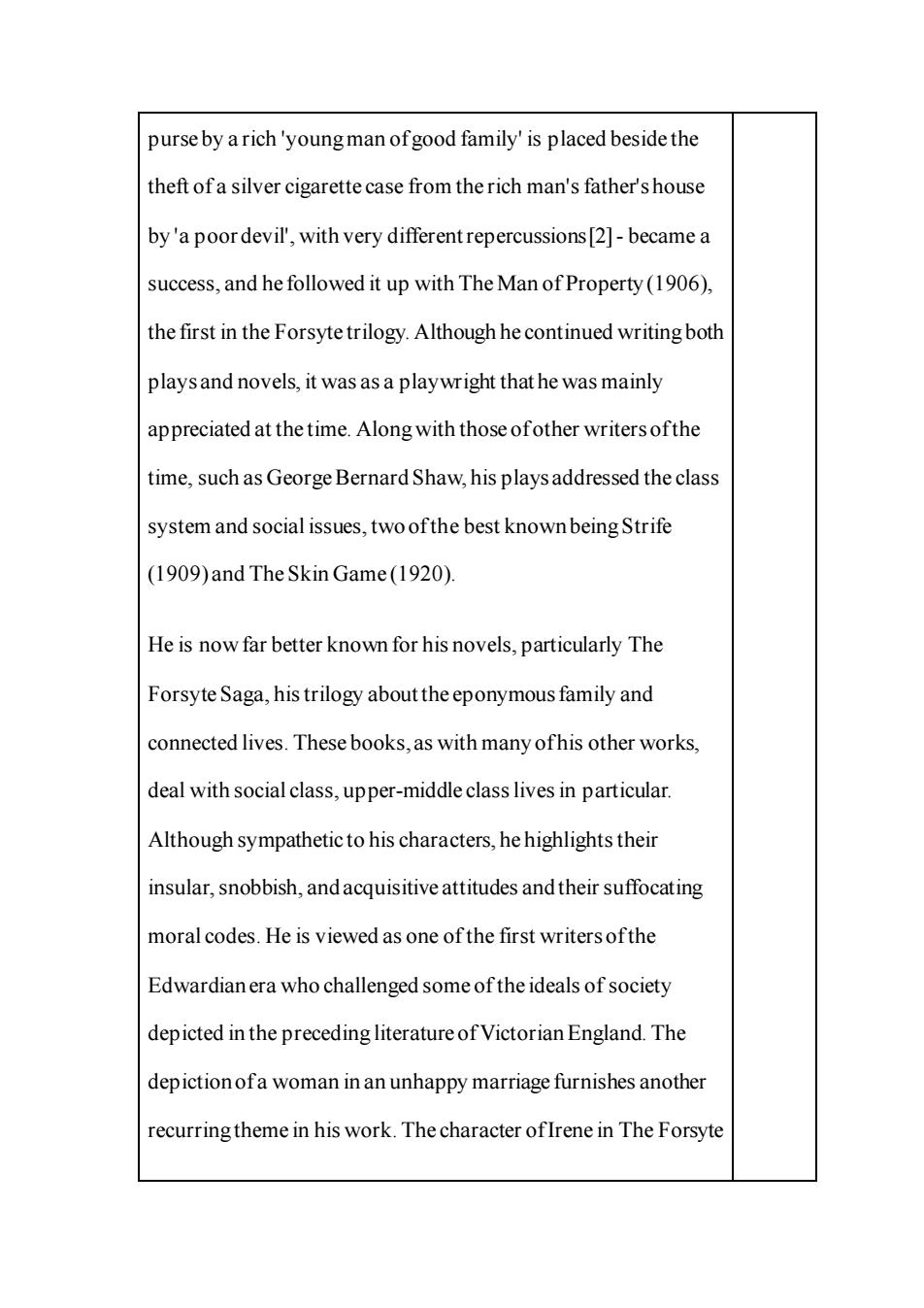
purse by arich'young man ofgood family'is placed beside the theft of a silver cigarette case from the rich man's father's house by'a poordevil',with very differentrepercussions[2]-became a success,and he followed it up with The Man of Property(1906), the first in the Forsyte trilogy.Although he continued writing both playsand novels,it was as a playwright that he was mainly appreciated at the time.Along with those ofother writersofthe time,such as George Bernard Shaw,his plays addressed the class system and social issues,twoofthe best known beingStrife (1909)and The Skin Game(1920). He is now far better known for his novels,particularly The Forsyte Saga,his trilogy about the eponymous family and connected lives.These books,as with many ofhis other works, deal with social class,upper-middleclass lives in particular. Although sympatheticto his characters,he highlights their insular,snobbish,and acquisitive attitudes and their suffocating moral codes.He is viewed as one ofthe first writers ofthe Edwardianera who challenged some of the ideals of society depicted in the preceding literature of Victorian England.The woman inan unhappy marriage furnishes nother recurringtheme in his work.The character ofIrene in The Forsyte
purse by a rich 'young man of good family' is placed beside the theft of a silver cigarette case from the rich man's father's house by 'a poor devil', with very different repercussions[2]- became a success, and he followed it up with The Man of Property (1906), the first in the Forsyte trilogy. Although he continued writing both plays and novels, it was as a playwright that he was mainly appreciated at the time. Along with those of other writers of the time, such as George Bernard Shaw, his plays addressed the class system and social issues, two of the best known being Strife (1909) and The Skin Game (1920). He is now far better known for his novels, particularly The Forsyte Saga, his trilogy about the eponymous family and connected lives. These books, as with many of his other works, deal with social class, upper-middle class lives in particular. Although sympathetic to his characters, he highlights their insular, snobbish, and acquisitive attitudes and their suffocating moral codes. He is viewed as one of the first writers of the Edwardian era who challenged some of the ideals of society depicted in the preceding literature of VictorianEngland. The depiction of a woman in an unhappy marriage furnishes another recurring theme in his work. The character of Irene in The Forsyte
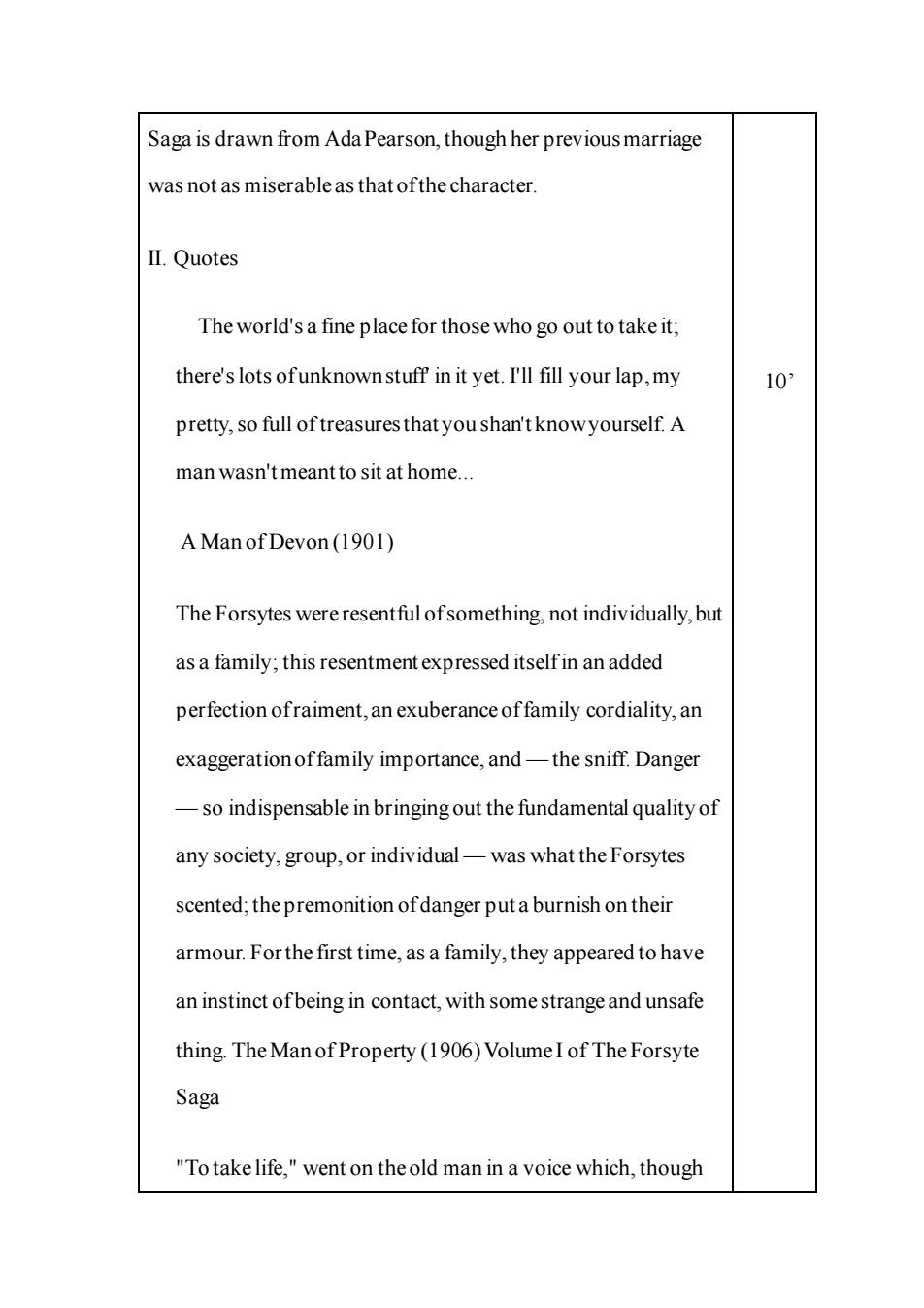
Saga is drawn from Ada Pearson,though her previous marriage was not as miserable as that ofthe character. II.Quotes The world's a fine place for those who go out to take it; there's lots ofunknownstuff in it yet.I'll fill your lap,my 6. pretty,so full of treasures that you shan't knowyourself.A man wasn't meant to sit at home. A ManofDevon(1901) The Forsytes wereresentful ofsomething,not individually,but as a family;this resentment expressed itselfin an added perfection ofraiment,an exuberance offamily cordiality,an exaggerationoffamily importance,and-the sniff.Danger -so indispensable in bringingout the fundamental quality of any society,group,or individual-was what the Forsytes scented;the premonition of danger puta burnish on their armour.Forthe first time,as a family,they appeared to have an instinct ofbeing in contact,with some strange and unsafe thing The Man of Property (1906)VolumeI of The Forsyte Saga "To take life,"went on the old man in a voice which,though
Saga is drawn from Ada Pearson, though her previous marriage was not as miserable as that of the character. II. Quotes The world's a fine place for those who go out to take it; there's lots of unknown stuff' in it yet. I'll fill your lap, my pretty, so full of treasures that you shan't know yourself. A man wasn't meant to sit at home. A Man of Devon (1901) The Forsytes were resentful of something, not individually, but as a family; this resentment expressed itself in an added perfection of raiment, an exuberance of family cordiality, an exaggeration of family importance, and —the sniff. Danger — so indispensable in bringing out the fundamental quality of any society, group, or individual — was what the Forsytes scented; the premonition of danger put a burnish on their armour. For the first time, as a family, they appeared to have an instinct of being in contact, with some strange and unsafe thing. The Man of Property (1906) Volume I of The Forsyte Saga "To take life," went on the old man in a voice which, though 10’
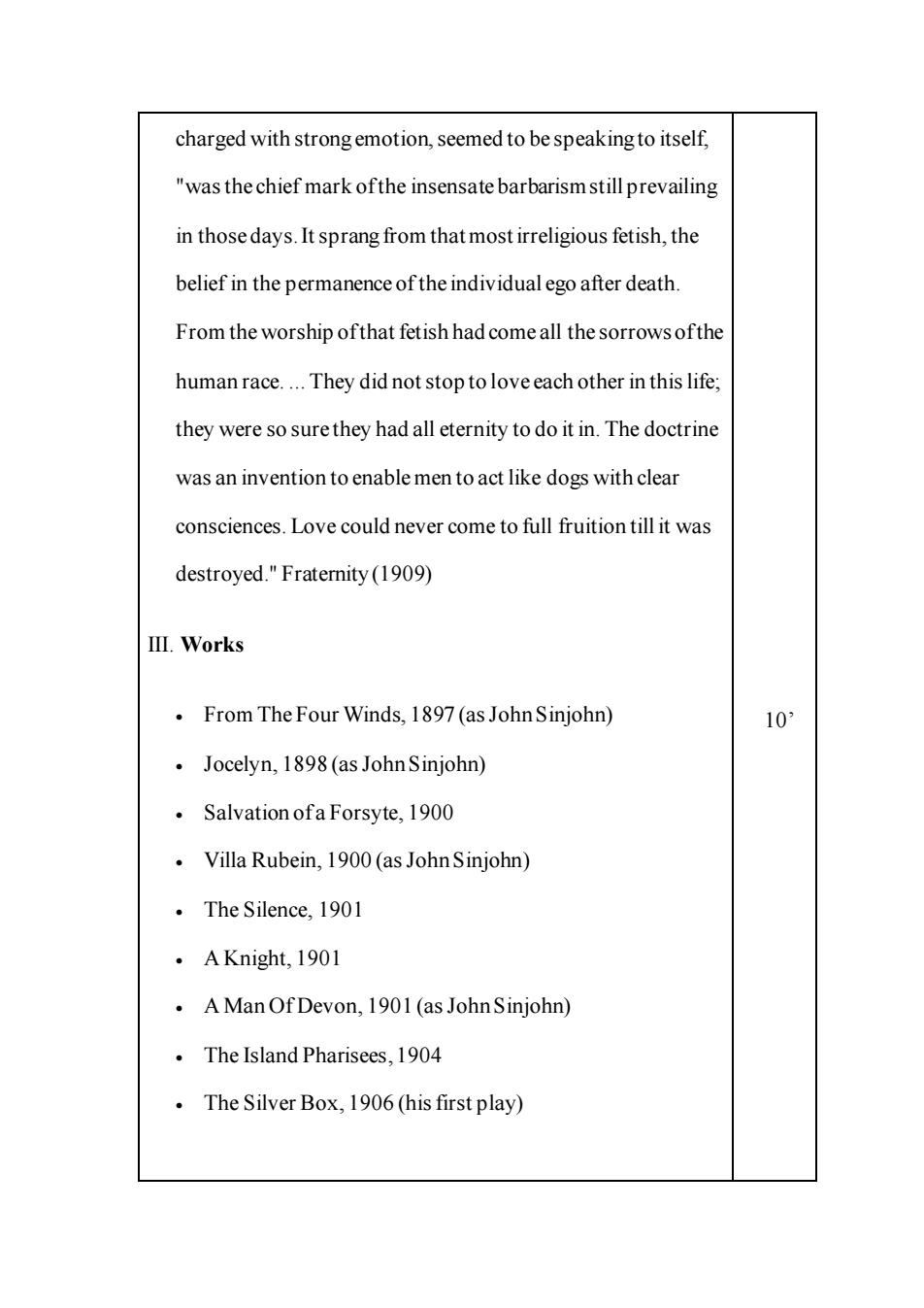
charged with strong emotion,seemed to bespeakingto itself, 'was the chief mark ofthe insensate barbarism still prevailing in those days.It sprang from that most irreligious fetish,the belief in the permanence ofthe individual ego after death From the worship ofthat fetish had come all the sorrows ofthe human race.They did not stop to loveeach other in this life they were so sure they had all eternity to do it in.The doctrine was an invention to enable men to act like dogs with clear consciences.Love could never come to full fruition till it was destroyed."Fraternity(1909) III.Works From The Four Winds,1897(as JohnSinjohn) 10 Jocelyn,1898(as JohnSinjohn) Salvation ofa Forsyte,1900 .Villa Rubein,1900(as JohnSinjohn) ·The Silence,.190l ·A Knight,1901 A Man Of Devon,1901(as JohnSinjohn) The Island Pharisees,1904 The Silver Box,1906(his first play)
charged with strong emotion, seemed to be speaking to itself, "was the chief mark of the insensate barbarism still prevailing in those days. It sprang from that most irreligious fetish, the belief in the permanence of the individual ego after death. From the worship of that fetish had come all the sorrows of the human race. . They did not stop to love each other in this life; they were so sure they had all eternity to do it in. The doctrine was an invention to enable men to act like dogs with clear consciences. Love could never come to full fruition till it was destroyed." Fraternity (1909) III. Works • From The Four Winds, 1897 (as John Sinjohn) • Jocelyn, 1898 (as John Sinjohn) • Salvation of a Forsyte, 1900 • Villa Rubein, 1900 (as John Sinjohn) • The Silence, 1901 • A Knight, 1901 • A Man Of Devon, 1901 (as John Sinjohn) • The Island Pharisees, 1904 • The Silver Box, 1906 (his first play) 10’

The Forsyte Saga,1906-1921 The Man of Property,1906 Indian Summer ofa Forsyte,1918(interlude) In Chancery,1920 Awakening,1920(interlude) To Let,1921 Points of View and Artistic Features John Galsworthy was essentially a bourgeois liberal,a 10 reformist;preoccupied with social injustice in his time,and regarded human life as a struggle between the rich and the poor Two classes in contrast:therich,a dull,parasitic and inhuman class,against any kind ofchange;the poor,an oppressed, rebellious and unyielding class,bent on reforming things. Galsworthy was a conventional writer,having inherited the fine traditions ofthe great Victoriannovelists ofthe critical realism With an objectiveobservation and a naturalistic description, Galsworthy had made an impartial presentation ofthe social life in documentary precision.By emphasizingthe criticalelement in his writing,he dauntlessly laid barethetrue features ofthe good
• The Forsyte Saga, 1906-1921 The Man of Property, 1906 Indian Summer of a Forsyte, 1918 (interlude) In Chancery, 1920 Awakening, 1920 (interlude) To Let, 1921 I. Points of View and Artistic Features John Galsworthy was essentially a bourgeois liberal, a reformist; preoccupied with social injustice in his time, and regarded human life as a struggle between the rich and the poor. Two classes in contrast: the rich, a dull, parasitic and inhuman class, against any kind of change; the poor, an oppressed, rebellious and unyielding class, bent on reforming things. Galsworthy was a conventional writer, having inherited the fine traditions of the great Victorian novelists of the critical realism. With an objective observation and a naturalistic description, Galsworthy had made an impartial presentation of the social life in documentary precision. By emphasizing the critical element in his writing, he dauntlessly laid bare the true features of the good 10’
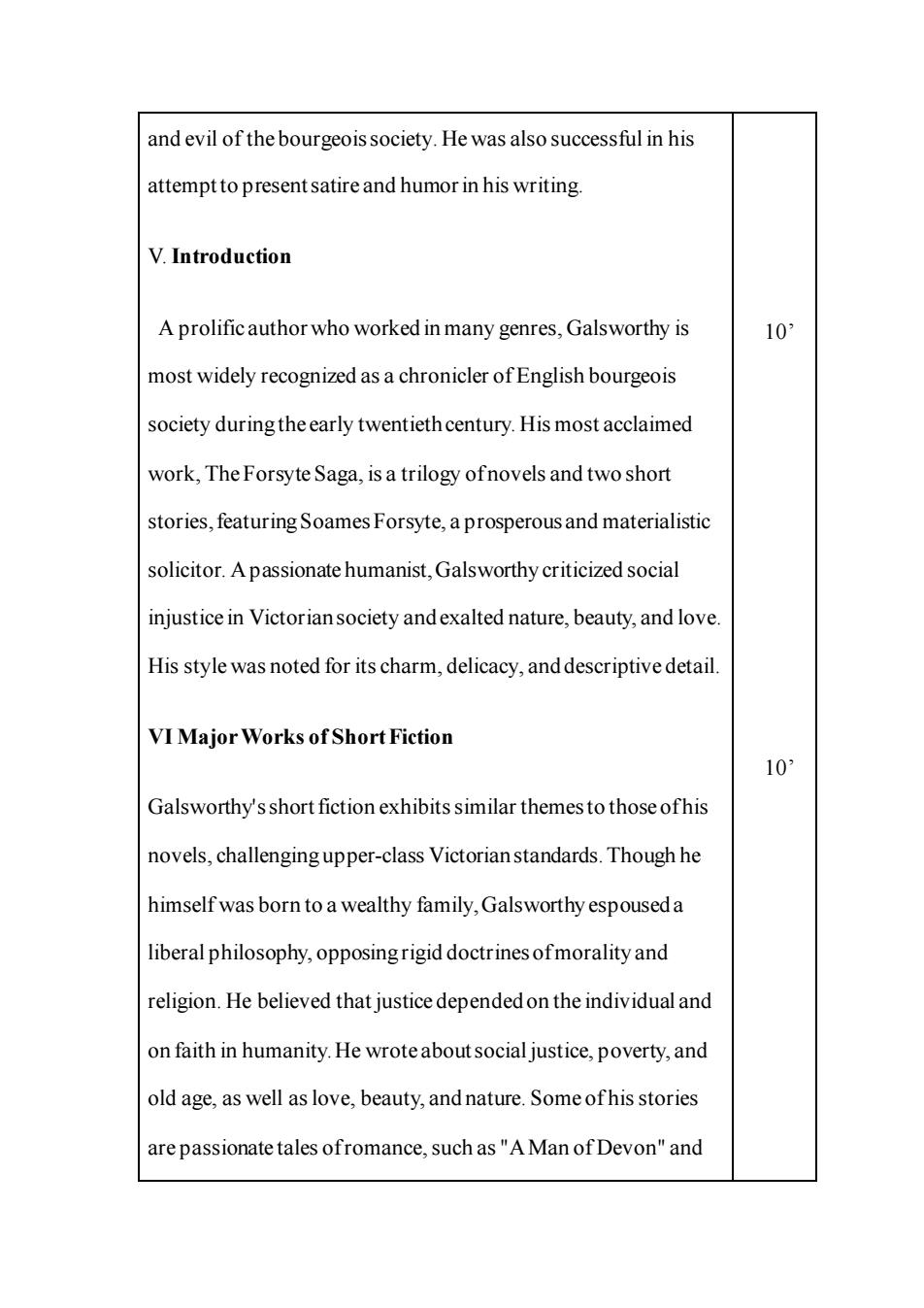
and evil of the bourgeoissociety.He was also successful in his attemptto presentsatire and humor in his writing. V.Introduction A prolific author who worked in many genres,Galsworthy is 10: most widely recognized as a chronicler of English bourgeois society duringtheearly twentieth century.His most acclaimed work,The Forsyte Saga,is a trilogy ofnovels and two short stories,featuring Soames Forsyte,a prosperous and materialistic solicitor.Apassionate humanist,Galsworthy criticized social injustice in Victoriansociety andexalted nature,beauty,and love. His style was noted for its charm,delicacy,and descriptive detail. VI Major Works of Short Fiction 10 Galsworthy's short fiction exhibits similar themes to those ofhis novels,challenging upper-class Victorianstandards.Though he himself was born to a wealthy family,Galsworthy espouseda liberal philosophy,opposing rigid doctrines ofmorality and religion.He believed that justice dependedon the individual and on faith in humanity.He wroteabout socialjustice,poverty,and old age,as well as love,beauty,and nature.Some ofhis stories are passionate tales ofromance,such as"A Man of Devon"and
and evil of the bourgeois society. He was also successful in his attempt to present satire and humor in his writing. V. Introduction A prolific author who worked in many genres, Galsworthy is most widely recognized as a chronicler of English bourgeois society during the early twentieth century. His most acclaimed work, The Forsyte Saga, is a trilogy of novels and two short stories, featuring Soames Forsyte, a prosperous and materialistic solicitor. Apassionate humanist, Galsworthy criticized social injustice in Victorian society and exalted nature, beauty, and love. His style was noted for its charm, delicacy, and descriptive detail. VI Major Works of Short Fiction Galsworthy's short fiction exhibitssimilar themes to those of his novels, challenging upper-class Victorian standards. Though he himself was born to a wealthy family, Galsworthy espoused a liberal philosophy, opposing rigid doctrines of morality and religion. He believed that justice depended on the individual and on faith in humanity. He wrote about social justice, poverty, and old age, as well as love, beauty, and nature. Some of his stories are passionate tales of romance, such as "A Man of Devon" and 10’ 10’

"The Apple Tree,"both ofwhich take place in the Devonshire countryside.The former features the relationship between a young girl,Paisance,and the man she falls in love with,Zachary Pearse.Tragically,Paisance,as she watches her love sail away on a voyage that she was forbidden by her grandfather to join,trips and falls from the edge ofa cliff to her death.In"The Apple Tree,"a man returnsafter twenty-six years to Devon,where he had deserted a relationship with a farm girl in order to pursue a wife of greater social status.Thestory focuses on theremorse that he feels about his past choice as well as the guilt that he 10 experiences upon discovering that the farm girl had committed suicide soon after he had left many yearsago.Sanford Sternlicht called "The Apple Tree"Galsworthy's"most finely crafted,most symbolic,and most poetic tale."Other stories are character portraitsor mood pieces such as"Spindleberries."Hecreated his visions in minute detail,imbuinga strong sense of atmosphere and character.In general,Galsworthy's stories tend to center more on charactersand their environment rather than plot.In many of his stories,Galsworthy empathizes with characters whoare anappreciated by society for their kindness and humanity.Those who are depicted as most admirable are individuals who recognize goodness and beauty in others.For instance.in The
"The Apple Tree," both of which take place in the Devonshire countryside. The former features the relationship between a young girl, Paisance, and the man she falls in love with, Zachary Pearse. Tragically, Paisance, as she watches her love sail away on a voyage that she was forbidden by her grandfather to join, trips and falls from the edge of a cliff to her death. In "The Apple Tree," a man returns after twenty-six years to Devon, where he had deserted a relationship with a farm girl in order to pursue a wife of greater social status. The story focuses on the remorse that he feels about his past choice as well as the guilt that he experiences upon discovering that the farm girl had committed suicide soon after he had left many years ago. Sanford Sternlicht called "The Apple Tree" Galsworthy's "most finely crafted, most symbolic, and most poetic tale." Other stories are character portraits or mood pieces such as "Spindleberries." He created his visions in minute detail, imbuing a strong sense of atmosphere and character. In general, Galsworthy's stories tend to center more on characters and their environment rather than plot. In many of his stories, Galsworthy empathizes with characters who are unappreciated by society for their kindness and humanity. Those who are depicted as most admirable are individuals who recognize goodness and beauty in others. For instance, in The 10’

Forsyte Saga,Irene leaves her husband,Soames,for Young Jolyon because Soames considers her his property and merely lusts for her,whereas Young Jolyon loves Irene and worships her beauty.In the idyllic"Indian Summer ofForsyte,"first published in Five Tales,Old Jolyon,an epicurean,dies as he sips an exquisite wine,as if from excess of delight.A Modern Comedy, on the other hand,denounces the post-World War I generation for their aimlessness and restlessness.Commentators have noted that while Galsworthy satirized the wealthy in his early works,he presented a more sympathetic view ofthe Forsytes in his later works,especially those collected in A Modern Comedy. Collectively,On Forsyte'Change,The Forsyte Saga,and A Modern Comedy have been referred to as "The Forsyte Chronicles." VII.Critical Reception Galsworthy's earliest work showed the influence of Conrad, 10 though Galsworthy insisted he was influenced most by Ivan Sergeevich Turgenev and Guy de Maupassant.His writings have also been comparedto those of Rudyard Kipling,Charles Dickens,and Katherine Mansfield.Galsworthy's talents were firs widely recognized in 1906 upon the publication ofhis novel The
Forsyte Saga, Irene leaves her husband, Soames, for Young Jolyon because Soames considers her his property and merely lusts for her, whereas Young Jolyon loves Irene and worships her beauty. In the idyllic "Indian Summer of Forsyte," first published in Five Tales, Old Jolyon, an epicurean, dies as he sips an exquisite wine, as if from excess of delight. A Modern Comedy, on the other hand, denounces the post-World War I generation for their aimlessness and restlessness. Commentators have noted that while Galsworthy satirized the wealthy in his early works, he presented a more sympathetic view of the Forsytes in his later works, especially those collected in A Modern Comedy. Collectively, On Forsyte 'Change, The Forsyte Saga, and A Modern Comedy have been referred to as "The Forsyte Chronicles." VII. Critical Reception Galsworthy's earliest work showed the influence of Conrad, though Galsworthy insisted he was influenced most by Ivan Sergeevich Turgenev and Guy de Maupassant. His writings have also been compared to those of Rudyard Kipling, Charles Dickens, and Katherine Mansfield. Galsworthy's talents were first widely recognized in 1906 upon the publication of his novel The 10’
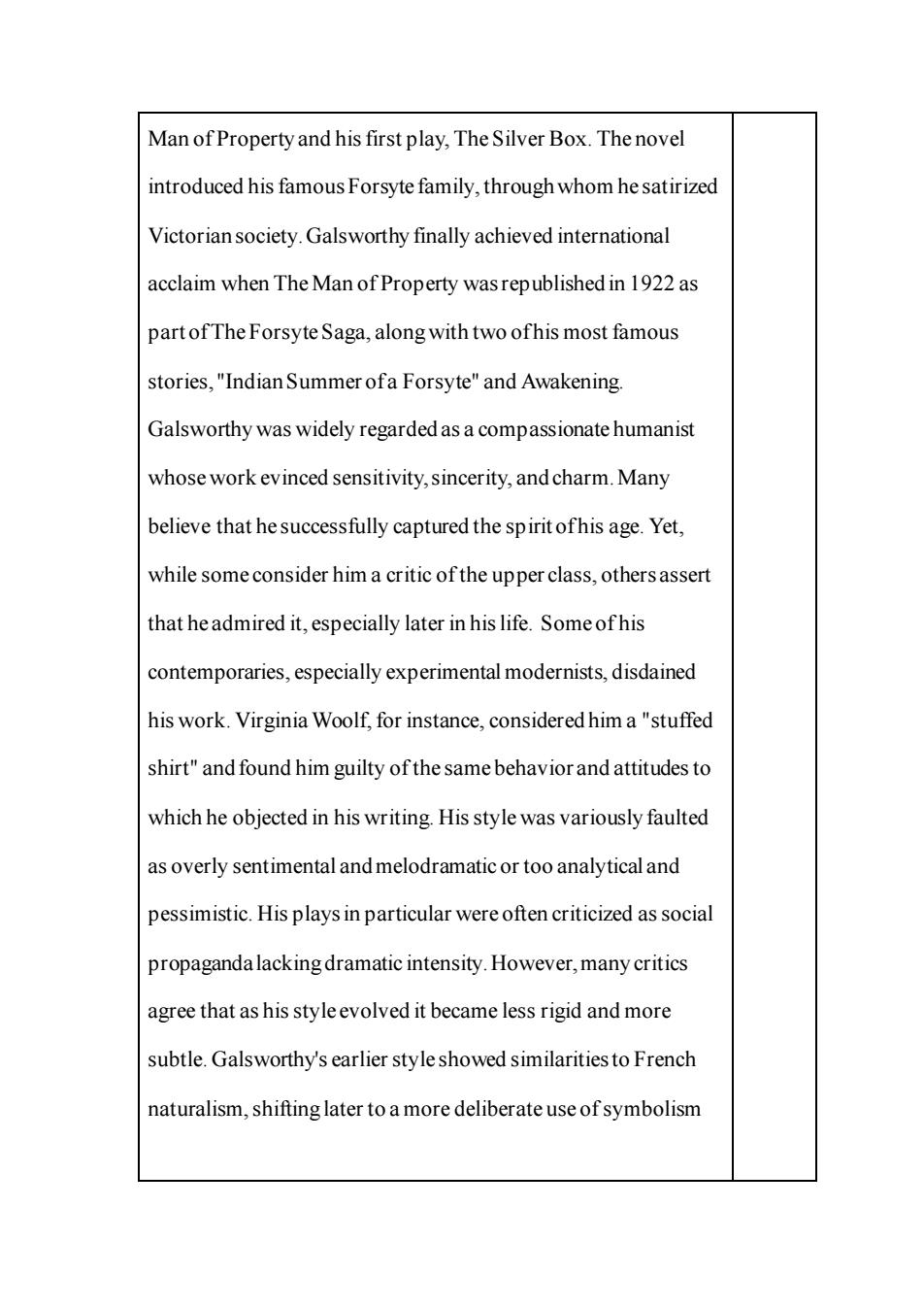
Man of Property and his first play,The Silver Box.The novel introduced his famous Forsyte family,through whom he satirized Victoriansociety.Galsworthy finally achieved international acclaim when The Man of Property wasrepublishedin 1922as part of The Forsyte Saga,along with two ofhis most famous stories,"Indian Summer ofa Forsyte"and Awakening. Galsworthy was widely regarded as a compassionate humanist whose work evinced sensitivity,sincerity,and charm.Many believe that hesuccessfully captured the spirit ofhis age.Yet, while some consider him a critic of the upper class,othersassert that headmired it,especially later in his life.Some ofhis contemporaries,especially experimental modernists,disdained his work.Virginia Woolf,for instance,considered him a"stuffed shirt"and found him guilty of the same behavior and attitudes to which he objected in his writing His style was variously faulted as overly sentimental and melodramatic or too analytical and pessimistic.His plays in particular were often criticized as social propagandalacking dramatic intensity.However,many critics agree that as his styleevolved it became less rigid and more subtle.Galsworthy's earlier style showed similarities to French naturalism,shifting later to a more deliberate use of symbolism
Man of Property and his first play, The Silver Box. The novel introduced his famous Forsyte family, through whom he satirized Victorian society. Galsworthy finally achieved international acclaim when The Man of Property was republished in 1922 as part of The Forsyte Saga, along with two of his most famous stories, "Indian Summer of a Forsyte" and Awakening. Galsworthy was widely regarded as a compassionate humanist whose work evinced sensitivity, sincerity, and charm. Many believe that he successfully captured the spirit of his age. Yet, while some consider him a critic of the upper class, others assert that he admired it, especially later in his life. Some of his contemporaries, especially experimental modernists, disdained his work. Virginia Woolf, for instance, considered him a "stuffed shirt" and found him guilty of the same behavior and attitudes to which he objected in his writing. His style was variously faulted as overly sentimental and melodramatic or too analytical and pessimistic. His plays in particular were often criticized as social propaganda lacking dramatic intensity. However, many critics agree that as his style evolved it became less rigid and more subtle. Galsworthy's earlier style showed similarities to French naturalism, shifting later to a more deliberate use of symbolism